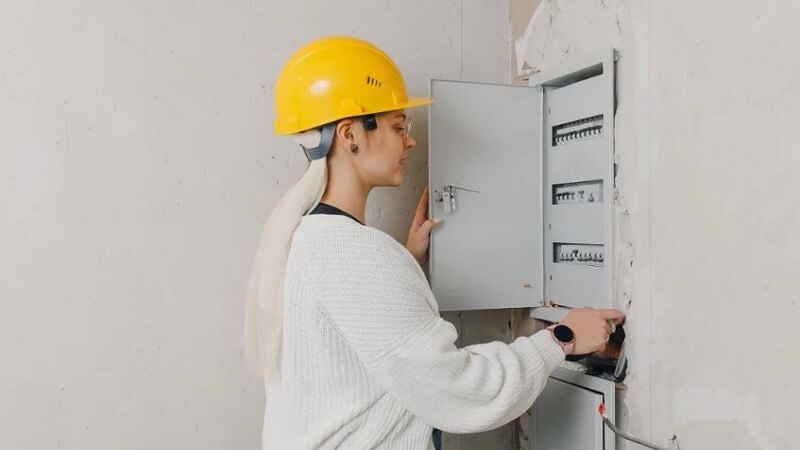For plumbers, HVAC technicians, and mechanical professionals, easy access to components makes maintenance more efficient. Without designated entry points, they may need to cut into drywall, remove ceiling panels, or work in tight spaces to reach essential systems, adding time, cost, and potential building damage.
Access doors and panels offer a practical solution, making service and repairs quicker and less disruptive. In this article, we’ll discuss the importance of accessibility in keeping plumbing, HVAC, and mechanical systems running efficiently.
Common Challenges in HVAC and Plumbing Maintenance
Before exploring the benefits of access doors and panels, it’s important first to recognize the issues many often face in HVAC and plumbing maintenance, including the following:
Workplace Hazards
Restricted access to HVAC and plumbing systems creates a variety of safety hazards for those performing maintenance and repairs. Working in cramped or awkward spaces can lead to muscle strain and injuries caused by repetitive motions or prolonged physical stress. Poor ventilation in these confined areas may expose workers to dust, fumes, or extreme temperatures, making conditions even more challenging.
Navigating around electrical wiring, pressurized systems, or sharp edges in spaces not designed for easy maneuverability adds another layer of risk. Limited visibility and restricted movement make handling tools more difficult, increasing the likelihood of accidents. Beyond immediate dangers, these conditions can also contribute to long-term health issues, underscoring the importance of improving accessibility in service areas.
Disruptions for Building Occupants
When accessing equipment is difficult, maintenance takes longer, creating disruptions that affect everyone at home. Noise carries through rooms, dust settles on surfaces, and daily routines are thrown off. Simple tasks become more complicated as repairs stretch, making it harder to relax or go about the day as usual.
Ongoing work interferes with comfort, whether it’s a loud repair during a quiet morning or an unexpected mess in a frequently used space. The longer it takes, the more it disrupts the flow of daily life, turning what should be a quick fix into an ongoing inconvenience.
Enhancing Maintenance Efficiency with Access Doors and Panels
Access solutions, like general purpose access doors, help streamline HVAC and plumbing maintenance, making it easier for technicians to perform their work. Here are some ways they improve maintenance efficiency:
Faster Access to Critical Components
One of the biggest headaches in system maintenance is trying to reach important components tucked behind walls, ceilings, or floors. Without an access panel, something as simple as shutting off a valve or checking an electrical box can turn into a messy job that involves cutting into drywall or pulling down ceiling tiles.
Access doors make things easier by providing a direct entry point to the systems that need attention. Instead of wasting time figuring out how to reach a hidden component, the focus stays on getting the job done quickly and with less hassle.
Minimized Property Damage
Without access doors, reaching concealed equipment often involves cutting into walls, ceilings, or floors, resulting in property damage that requires drywall repairs, repainting, and ceiling tile replacements. These added expenses also extend service times and cause further disruptions.
A planned access solution allows repeated entry without affecting the building’s structure. This is especially valuable not only in residential spaces, but also in commercial buildings and industrial facilities.
Reduced Labor Costs
Time is valuable in the service industry, and unnecessary delays can quickly increase labor costs. When reaching essential components requires cutting into walls or dismantling structures, service takes longer and becomes more expensive. Access doors provide a simple solution, allowing work to begin immediately instead of wasting time on preparation.
Quicker Emergency Repairs
When a system failure occurs, response time is critical. Whether it’s a plumbing leak, HVAC malfunction, or electrical failure, delays in reaching the affected component can lead to increased damage, service disruptions, and higher repair costs.
With access panels, technicians and plumbers can respond more quickly, reducing downtime and preventing minor issues from escalating into larger problems. In emergencies, such as gas leaks or electrical faults, rapid access to shut-off valves or breaker panels can prevent further damage and enhance overall building safety.
Adaptability for Future Upgrades
Building systems change over time due to technological advancements, efficiency standards, and tenant needs. When access to mechanical, plumbing, and electrical infrastructure is limited, modifications and upgrades become more complex and costly.
Strategically placed access panels allow future upgrades to be completed with minimal disruption. Whether installing new HVAC components, expanding plumbing systems, or integrating smart building technology, easy access to existing infrastructure simplifies modifications and keeps costs manageable.
Selecting the Right Access Panels
Not all access doors are suited for every application, and selecting the right type requires careful consideration of several factors. The space’s environment, function, and security requirements all influence which access panel will perform best.
Choosing the appropriate panel ensures efficient servicing, protects critical components, and preserves the overall aesthetics of the space.
Material and Durability
The material of an access panel affects its longevity, resistance to environmental conditions, and suitability for specific applications. In high-moisture environments such as bathrooms, kitchens, and outdoor settings, stainless steel panels offer superior corrosion resistance, preventing rust and deterioration over time. They are ideal for coastal regions or areas with frequent exposure to humidity and water.
For industrial applications, heavy-duty steel panels provide enhanced strength and durability. These solutions withstand heavy use, impacts, and harsh environmental conditions in manufacturing plants, warehouses, and mechanical rooms.
Size and Placement
The dimensions of an access panel should align with the size of the components it serves while fitting within the available installation space. A panel that is too small can make maintenance difficult by limiting movement, while an oversized panel may take up unnecessary space or disrupt the surrounding design.
For areas that require frequent servicing, larger panels give technicians the room needed to work efficiently, reducing the difficulty of repairs and inspections. Sufficient space allows for easier tool use, clearer visibility, and smoother handling of components during maintenance.
Aesthetic Considerations
In a well-designed space, functionality shouldn’t come at the expense of appearance. Most access panels provide a practical way to reach essential systems, but they should do so without standing out or disrupting the overall look of a room. Flush-mounted panels sit level with walls or ceilings, maintaining a smooth, seamless finish without bulky protrusions.
For a more customized approach, paintable access panels allow easy blending with surrounding surfaces. Matched to the existing color scheme, they become nearly unnoticeable, ensuring quick access to plumbing, electrical, or mechanical components when needed. With the right design choices, accessibility remains convenient without compromising the space’s style.
To Sum Up
Ensuring that essential components are accessible makes routine maintenance and repairs much easier. By reducing the need for invasive work, well-planned access points help technicians, plumbers, and service designers complete tasks more efficiently, keeping systems functional and reducing long-term wear.

